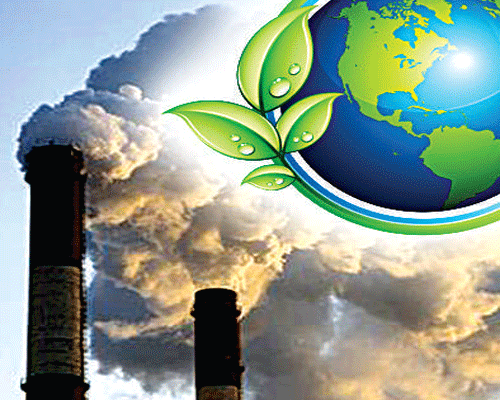
Are the nation’s development issues coming to blows with its environment issues? The question how India is going to strike a balance in the three fronts – economy, energy and environment – going by the eagerness of the Narendra Modi government to promote industrialisation and ensure high economic growth – is gaining traction in view of the ensuing changes of the existing environment and land acquisition laws of India.
Going by the modest joint statement issued by the US and India that set modest goals on clean energy and climate change, Prime Minister Modi and American President Barack Obama made a personal commitment to work together to pursue a strong global climate agreement in Paris slated later this year.
We maintain that India being the world’s third-largest greenhouse gas polluter – though beset by a high population growth rate – has one of the lowest per capita rates of greenhouse gas emissions, about roughly 1/20th of the US and Australia. Millions of people in small islands, least-developed countries, landlocked countries as well as vulnerable communities in Brazil, India and China, and all around the world – are suffering from the effects of a problem to which they did not contribute. The argument for industrial development for countries such as Brazil and India are compelling.
The one-third of the world's population lives in the most heavily industrialised nations (commonly termed developed countries – DCs) accounting for 85 per cent of the global personal income and a like fraction of the annual use of global resources. The people living in the less industrialised nations (often called less developed countries – LDCs) must apportion the remaining 15 per cent of global income and resource use among two-thirds of the world's population. The result is an unconscionable prosperity for the majority of people in the DCs and crushing poverty for the majority in the LDCs.
The argument gets fraught here and politics takes over. The prosperity of the DCs – obscene by comparison with the poverty of the LDCs – has been built on exploitation of the richest soils, the most accessible fossil fuels, and the most concentrated mineral deposits of the entire earth. As they now struggle to maintain and even expand their massive consumption from a resource base of declining quality, the LDCs, as they try to follow the same path to economic development, find the bridges burnt ahead of them.
A DC-style industrialisation of the LDCs, based on the expensive resources that remain, is therefore probably foredoomed by enormous if not insurmountable economic and environmental obstacles. Therefore, however much we clamour that we have a natural right to seek industrial development with greater rapacity to catch up with the industrialised west, odds are heavily stacked against the environment.
If all the people in India and China seek to own passenger cars at the rate of the US or own as much air conditioners, that would be an environmental disaster.Today, the global thinking is that India and China will engulf the planet with their economic development.
Is there no middle path between the industrial and environmental activism? Development does not mean always luxury and negligence towards environment. Some Asian cities with strong governments are actively and effectively pursuing strategies to slow motorisation by providing high quality public transport. Are not we, in our gung-ho attitude clamouring for industrial growth, considering environmentalism as an obstructionist fad?
As is made out, Minister of State for Environment Prakash Javadekar has delinked forest approval from clearance by the National Board of Wild Life and halved NBWL clearance requirements from 10 km to 5 km around forest reserves. He had sidelined eminent experts and concerned NGOs. He had diluted procedures for the application of the Forest Conservation Act (FCA) for exactly those areas where FCA applies most – linear projects in forest areas, eco sensitive areas along the international border and areas affected by Naxalism.
Environmental legislations
A whole range of environmental protection legislation including the Environment Protection Act, the Wildlife Protection Act, the Forest Conservation Act, and the Water and Air Pollution Act has come under fire possibly in the plea that they are major irritants in the path of India’s industrial growth. The Land Acquisition Act, for instance, has been the cause for major worry for its rights-based approach and might come for heavy pruning if not the axe under the new political dispensation.
Or, take the instance how the ruling NDA is flouting the direction in September 2013 by the UPA’s environment ministry to the Central Pollution Control Board to reassess the Comprehensive Environmental Pollution Index, an important criterion for project clearance, while keeping intact the moratorium on new industries in critically-polluted areas. The ministry has lifted the moratorium in eight critically polluted areas – Ghaziabad, Indore, Jharsuguda, Ludhiana, Panipat, Patancheru-Bollaram, Singrauli and Vapi. The report of the high-powered committee to review six top environmental laws of the country, headed by former cabinet secretary TSR Subramanian, prepared in just three months, justified the hyper-ventilation of the NDA ministry, on the grounds of “doing business easier in the country”.
We surely cannot be denied of our right to industrial growth and material prosperity but that should not happen at the cost of our environment in view of the larger and the more entrenched costs it might impose on our economy. In view of Modi's challenges to bring power to India’s 300 million – equivalent to the entire population of the US - it is understood why it cannot commit to emissions targets or even a cap year at this stage of its development.
Still, we need to embrace a grand scale of economic planning and management to transform our economy so that it is less resource-intensive. India must stick to its commitments to clean energy like phasing out hydrofluorocarbons and meeting a domestic goal of producing 1,00,000 MW of solar power by 2022.